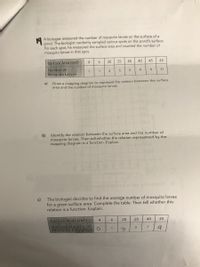
Algebra and Trigonometry (6th Edition)
6th Edition
ISBN: 9780134463216
Author: Robert F. Blitzer
Publisher: PEARSON
expand_more
expand_more
format_list_bulleted
Concept explainers
Topic Video
Question
thumb_up100%

Transcribed Image Text:A biologist measured the number of mosquito larvae on the surface of a
pond. The biologist randomly sampled various spots on the pond's surface.
For each spot, he measured the surface area and counted the number of
mosquito larvae in that spot.
Surface Area (cm³)
4
6.
20
25
40
40
45
45
Number of
Mosquito Larvae
1
1
4
5
9
11
Draw a mapping diagram to represent the relation between the surface
area and the number of mosquito larvae.
a)
Identify the relation between the surface area and the number of
mosquito larvae. Then tell whether the relation represented by the
mapping diagram is a function. Explain.
b)
c)
The biologist decides to find the average number of mosquito larvae
for a given surface area. Complete the table. Then tell whether this
relation is a function. Explain.
Surface Area (cm²)
4
6
20
25
40
45
Average Number of
Mosquito Larvae
1
Expert Solution
This question has been solved!
Explore an expertly crafted, step-by-step solution for a thorough understanding of key concepts.
This is a popular solution
Trending nowThis is a popular solution!
Step by stepSolved in 3 steps with 4 images

Knowledge Booster
Learn more about
Need a deep-dive on the concept behind this application? Look no further. Learn more about this topic, algebra and related others by exploring similar questions and additional content below.Similar questions
- find the point estimate for observation.arrow_forwardBianca is a swimmer training for a competition. The number of 50-metre laps she swam each day for 30 days are as follows: 22, 21, 24, 19, 27, 28, 24, 25, 29, 28, 26, 31, 28, 27, 22, 39, 20, 10, 26, 24, 27, 28, 26, 28, 18, 32, 29, 25, 31, 27.Draw the stem and leaf plot by splitting the stems into five-unit intervals. Explain what the plot shows.arrow_forwardSuppose a researcher collects data on the air pollution levels, measured in milligrams per cubic meter, for both urban and rural areas in 35 states. The data is plotted with urban air pollution levels on the horizontal axis and rural air pollution levels on the vertical axis. Nevada is an outlier in the ?x‑direction. What must be true about this state? The urban air pollution levels for this state are much higher or lower than the rest of the states in the data set. The rural air pollution levels for this state are much higher or much lower than the rest of the states in the data set. This state is an influential observation. The rural air pollution levels for this state are much higher or lower than other states in the data set that have similar urban air pollution levels. The absolute value of the residual of this state is large.arrow_forward
- Use a stem-and-leaf plot to display the data, which represent the numbers of hours 24 nurses work per week. Describe any patterns. 40 40 46 48 31 40 27 40 36 40 36 36 52 32 36 40 35 D 40 33 40 32 38 30 29 Determine the leaves in the stem-and-leaf plot below. Key: 313=33 Hours worked 3 4 51 (---))arrow_forwardFor each type of chart determine the type of variable that should be usedarrow_forwarda and b pleasearrow_forward
arrow_back_ios
arrow_forward_ios
Recommended textbooks for you
 Algebra and Trigonometry (6th Edition)AlgebraISBN:9780134463216Author:Robert F. BlitzerPublisher:PEARSON
Algebra and Trigonometry (6th Edition)AlgebraISBN:9780134463216Author:Robert F. BlitzerPublisher:PEARSON Contemporary Abstract AlgebraAlgebraISBN:9781305657960Author:Joseph GallianPublisher:Cengage Learning
Contemporary Abstract AlgebraAlgebraISBN:9781305657960Author:Joseph GallianPublisher:Cengage Learning Linear Algebra: A Modern IntroductionAlgebraISBN:9781285463247Author:David PoolePublisher:Cengage Learning
Linear Algebra: A Modern IntroductionAlgebraISBN:9781285463247Author:David PoolePublisher:Cengage Learning Algebra And Trigonometry (11th Edition)AlgebraISBN:9780135163078Author:Michael SullivanPublisher:PEARSON
Algebra And Trigonometry (11th Edition)AlgebraISBN:9780135163078Author:Michael SullivanPublisher:PEARSON Introduction to Linear Algebra, Fifth EditionAlgebraISBN:9780980232776Author:Gilbert StrangPublisher:Wellesley-Cambridge Press
Introduction to Linear Algebra, Fifth EditionAlgebraISBN:9780980232776Author:Gilbert StrangPublisher:Wellesley-Cambridge Press College Algebra (Collegiate Math)AlgebraISBN:9780077836344Author:Julie Miller, Donna GerkenPublisher:McGraw-Hill Education
College Algebra (Collegiate Math)AlgebraISBN:9780077836344Author:Julie Miller, Donna GerkenPublisher:McGraw-Hill Education

Algebra and Trigonometry (6th Edition)
Algebra
ISBN:9780134463216
Author:Robert F. Blitzer
Publisher:PEARSON

Contemporary Abstract Algebra
Algebra
ISBN:9781305657960
Author:Joseph Gallian
Publisher:Cengage Learning

Linear Algebra: A Modern Introduction
Algebra
ISBN:9781285463247
Author:David Poole
Publisher:Cengage Learning

Algebra And Trigonometry (11th Edition)
Algebra
ISBN:9780135163078
Author:Michael Sullivan
Publisher:PEARSON

Introduction to Linear Algebra, Fifth Edition
Algebra
ISBN:9780980232776
Author:Gilbert Strang
Publisher:Wellesley-Cambridge Press

College Algebra (Collegiate Math)
Algebra
ISBN:9780077836344
Author:Julie Miller, Donna Gerken
Publisher:McGraw-Hill Education